|
By Jack Dangermond
Last year's User Conference theme was "GIS—Geography in Action." This conference both showcased and 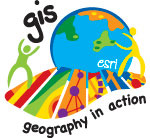 acknowledged the incredible work and progress of GIS users around the world. Their creative and innovative efforts provide evidence of the growing value of GIS in almost every field of human endeavor. acknowledged the incredible work and progress of GIS users around the world. Their creative and innovative efforts provide evidence of the growing value of GIS in almost every field of human endeavor.
These efforts are part of a long history of geography in action. More than 200 years ago, geographer Alexander von Humboldt first introduced the idea of geography as an integrative science. Von Humboldt's holistic view considered the world as a series of interrelated geographic processes that could be described and used to predict the future. His writings described the relationships between forest cutting and soil erosion, as well as climate and soils and their relationship to agricultural productivity.
Von Humboldt's studies were followed by an age of scientific specialization (e.g., geology, biology, climatology). While this resulted in enormous advancement in knowledge, it also resulted in less focus on a holistic, or overall, vision of nature.
In the late 19th century, horticulturist and early landscape architect Warren Manning used map overlays as a way to combine various physical and cultural geographic factors for site and regional planning. His early efforts attempted to integrate geographic data to help make decisions about land-use plans.
Ian McHarg, also a landscape architect and ecological planner, went on to popularize this integration approach in his book Design with Nature. He advocated using geographic overlays as a framework for ecology-based land-use planning, and through his teachings, writing, and professional practice, he developed a significant following among both professionals and society at large.
Still later, Waldo Tobler, the first geographic information scientist, used quantitative methods, algorithms, and software tools to analytically model geographic processes. His work advanced the theoretical framework of geography and opened the door to understanding how we could use computers to model our world. In the 1960s, Roger Tomlinson went on to conceive and build the first geographic information system in Canada. His ideas not only pioneered what we now call a GIS—he also demonstrated the feasibility of these ideas by constructing the first fully functioning system. At about the same time, Carl Steinitz, an urban planner at Harvard University, originated many of the early ideas about the application of GIS for landscape analysis and urban planning.
All these pioneers had something in common—they were using geography to create a better understanding of our world and to solve geographic problems. Today, GIS professionals are accelerating the creation and use of geographic knowledge and its application to nearly every problem confronting society.
GIS in a Rapidly Changing World
Currently, population growth and human actions are significantly impacting our natural world. We are rapidly changing our climate, the biodiversity of the planet, and the ecosystems that support human life. These changes are in turn affecting our economies and our security and challenging sustainability for all of us.
At the same time, GIS technical advancement and adoption are accelerating. These trends are changing everything. GIS is providing a new way to abstract our world: digital geographic knowledge. This knowledge is being organized with geographic data and data models, mathematical models that describe geographic processes, digital maps and globes that visualize our world, and geospatial workflows that manage our work. Metadata is increasingly used to describe each of these abstractions in such a way that we can catalog and discover more about what is known.
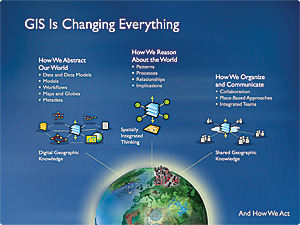
GIS is systematically organizing geographic knowledge into easily shareable information. This sharing of knowledge is changing how we communicate and collaborate. Today, integrated teams and place-based approaches are becoming the standard for complex problem solving.
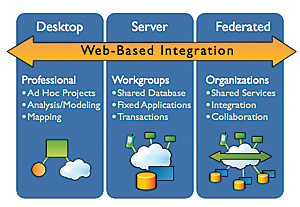
GIS is changing how we think and reason about our world. It allows us to better study relationships, patterns, and processes, as well as what they mean. These capabilities have resulted in more spatially integrated thinking.
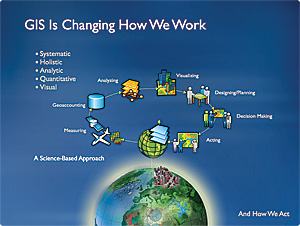
Finally, GIS is changing how we work. It provides a science-based approach, connecting geospatial measurement and data collection with data management; spatial analysis and modeling; geospatial visualization; design and planning; decision making; and ultimately, human action. The benefits of this approach are that it is systematic, holistic, analytic, quantitative, and visual. As such, it speaks to people through a new medium. This approach can handle large volumes of data; support complexity; and be transparent, repeatable, collaborative, and crosscutting, thus embodying many of the attributes of what we desperately need today to better manage our world.
GIS and the work of GIS professionals are important. They result in saving resources, making organizations more efficient, and supporting better decision making. This means more sustainable action—an emerging goal of increasing importance to all of us.
GIS Today and in the Future
Today, GIS implementations follow three common patterns: desktop, server, and federated systems. Federated systems combine servers and services for collaboration across organizations. These three patterns create the foundation for a new and emerging pattern—Web GIS.
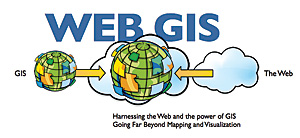
Web GIS involves authoring geographic knowledge, including data, models, workflows, and maps, then serving those resources to other users. Web GIS harnesses the power and reach of the Web and integrates the rich knowledge resources of GIS—authoritative databases, models, and spatial analysis. Web GIS goes far beyond simple visualization and mapping and provides access to full geographic knowledge to everyone. Over time, Web GIS will become an essential part of the infrastructure of society.
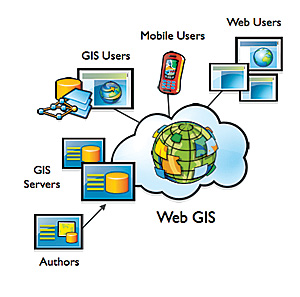
The Role of GIS Professionals
GIS professionals will play an important role in implementing this Web GIS infrastructure by authoring and serving geographic knowledge. High-quality maps and visualization will be part of it, but only the beginning. Analytics, models, and geoprocessing will be integrated. Authoritative content and powerful Web applications will be delivered. GIS professionals will construct large libraries of services and support these services with a distributed architecture and infrastructure that many will access, including citizens and consumers, knowledge workers, mobile users, and other GIS users inside and outside an organization. Also, the services of Web GIS will increasingly be integrated into enterprise IT systems.
This Web platform will dramatically leverage the work of GIS professionals and significantly enhance our collective knowledge.
In the Future, GIS Will Become a Pervasive Part of All Human Action
Today, there are hundreds of GIS applications operating in hundreds of thousands of organizations with millions of users around the world. These applications are being applied across all industries, such as government, business, education, nongovernmental organizations, and utilities. This is only the beginning. With the evolution of enabling technologies, geographic knowledge will be available to everyone and will affect all human activities.
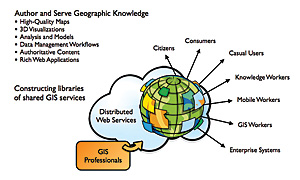
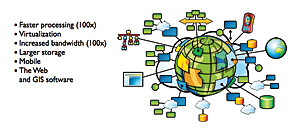
Esri Software Development
At Esri, our strategy is to build a complete and integrated GIS software platform (ArcGIS software platform). While our vision for this technology is primarily focused on providing useful tools for specific applications, it is also a platform for realizing the integrative vision of geography as expressed above. ArcGIS consists of a series of four components that are used to implement the various GIS patterns described previously. These components provide building blocks to support full enterprise implementations.
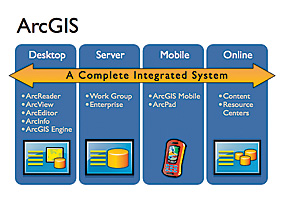
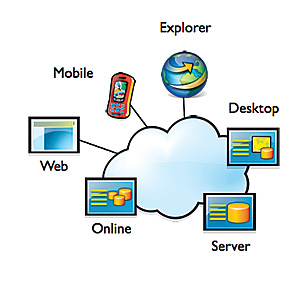
- The Geodatabase—While not new, it is important to stress that the foundation for ArcGIS is the geodatabase (GDB). The geodatabase is an information model and physical container for organizing and managing geospatial data. The geodatabase environment is simple, highly preformatted, and scalable. Geodatabase models support virtually any type of geographic data, including image and raster data, vector features and their attributes, terrains, addresses, 3D objects, surveys, and maps. The storage environment of the geodatabase can be in files or in a DBMS.
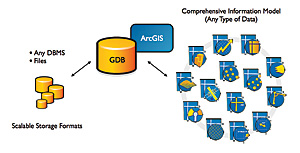
Historically, many GIS users have used shapefiles as their core data structure. For ArcGIS users, the geodatabase is much richer—capable of better modeling geographic phenomena and leveraging the full analytic and display capabilities of ArcGIS software.
- Improving Geographic Science and Cartography—With each release, Esri focuses on advancing our technology as well as underlying geographic science. Dozens of new capabilities were introduced at 9.3 that improve the spatial analysis and modeling capabilities of ArcGIS. Likewise, specialized capabilities were introduced that allow users to make better maps. They include improvements to labeling, symbology, and automation to create high-quality displays.
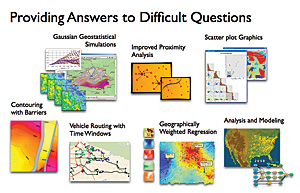
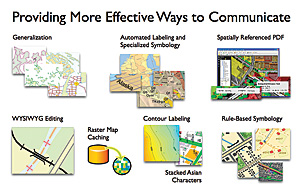
- Integration with the Web—At 9.3, ArcGIS was engineered to integrate extensively with the Web environment. Specifically, there are many improved capabilities to read and distribute Web content (e.g., maps and data) in both the desktop and server environments.
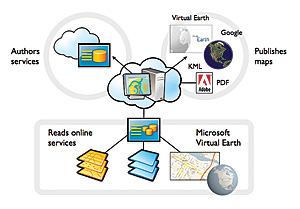
- 3D Visualization and Analysis—At 9.3, visualization is much faster, smoother, and more accurate and also incorporates geometric analysis tools to perform full 3D analytic operations.
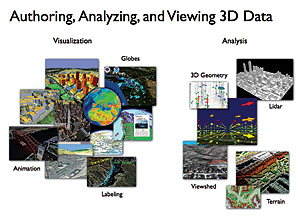
ArcGIS Server
ArcGIS Server is Esri's strategic product for Web and enterprise GIS. At 9.3, we have made enormous progress in providing an open, scalable system that serves geographic knowledge to virtually any client. We have also made the server environment simple. ArcGIS Server is being implemented in a series of patterns within the user community. These patterns include using ArcGIS Server as a mapping server, to support mobile applications, to align geoservices and business systems in an enterprise, as part of the spatial data infrastructure where multiple departments replicate data into an enterprise warehouse, as a fusion center, and to support mashups. All these patterns represent various ArcGIS Server implementations, and while useful to distinguish separately, they can also be thought of as integrated capabilities of a Web GIS.
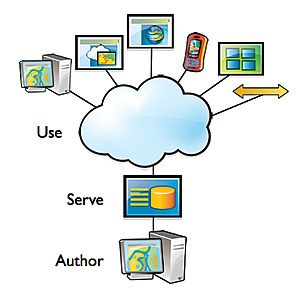
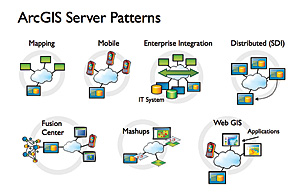
Fusion Centers—The fusion center pattern is a new type of GIS that is increasingly being implemented to provide situational awareness for organizations. In a fusion center, many GIS databases, as well as dynamic services, are brought together and integrated into a single environment that supports applications where real-time visualization of geospatial data is important (emergency response, utility operations, etc.). The fusion center pattern allows communities to interact in real time with data and services that have been encapsulated and made available for use.
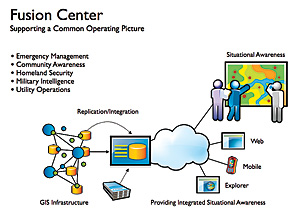
Mashups—At 9.3, Esri released a new REST API that supports JavaScript mashups. This means developers are able to easily combine various types of Web services using simple scripting. This process can combine multiple map overlays in lightweight applications that are easily created by anyone.
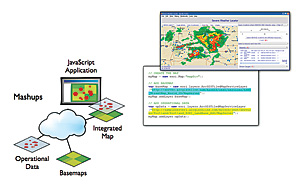
GIS professionals are increasingly providing access to their content as geoservices that can be shared with other users via the Web. These services, combined with the capability to easily create JavaScript applications that link multiple services dynamically, will create a whole new community of less technical users that will benefit enormously. Harnessing the power of the Web in this way will put the vast knowledge of GIS into the hands of everyone, and the result will be dramatic leveraging of the investments that have been made in geospatial databases.
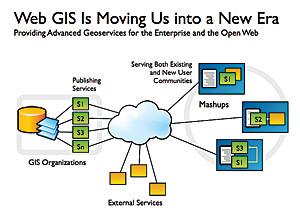
Mobile Applications
GIS is rapidly extending into the mobile environment. Esri supports three kinds of mobile applications: those based on ArcGIS Desktop and ArcGIS Engine, ArcPad, and ArcGIS Mobile. At 9.3, we released an ArcGIS Mobile application that is fully integrated with ArcGIS Server. This new application supports a server pattern that allows geoservices to be extended into the field in a rich "sometimes connected" environment. ArcGIS Mobile allows real-time data exchange that makes field-workers more efficient and connects their work in a near real-time environment, enabling more coordinated decision making.
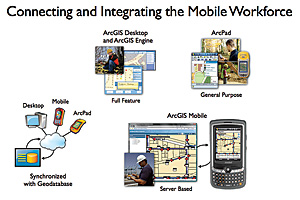
Imagery Is Becoming an Integral Part of GIS
At 9.3, imagery has been integrated as a core part of ArcGIS. This includes technology enhancements that support multiple workflows associated with collection, management, production, and exploitation of imagery. Specifically, ArcGIS Server now fully integrates server-side image processing and serving. This complements a rich capability for image management and dissemination. High-performance image services support not only Esri's various clients but also virtually any image analysis and feature extraction technology. This integration means that image processing and GIS are coming together through common data management and services that support multiple environments.
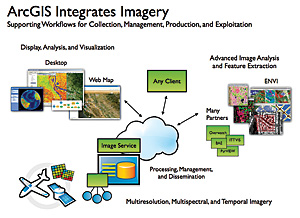
Geobrowser Technology Is Expanding GIS for Everyone
ArcGIS Explorer is a downloadable "geobrowser" that makes GIS available to everyone. This free software client provides access to advanced visualization and map services, as well as advanced spatial analysis capabilities supported by ArcGIS Server. ArcGIS Explorer has been continuously improving with rapid development cycles that deliver new features quickly. Some of the recent improvements include the ability to e-mail a result (maps or visualizations), easily print results, and hyperlink to any number of multimedia services. Esri is committed to evolving this powerful technology. In the next few months, Esri will release a new version of ArcGIS Explorer that offers integrated 2D/3D viewing and a host of new usability enhancements.
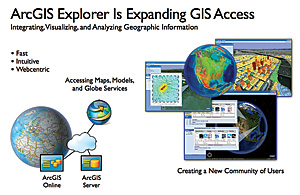
GIS and Online Web Services—ArcGIS Online
Esri is investing heavily in a new program of online geoservices. While content has always been part of ArcGIS, ArcGIS Online provides much of this content in the form of services that are free to desktop and server users. There is also a growing library of commercial content services that users can subscribe to. This spring, Esri will release a new and powerful extension to ArcGIS Online that will allow users to share their data and maps through the rapidly growing computing environment.
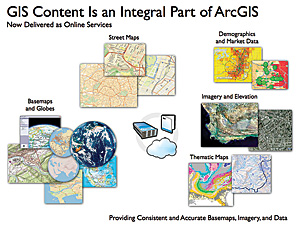
GIS Professionals Are Contributing
Our User Conference is perhaps the best place to grasp the magnitude of how GIS professionals are affecting the world. Their work is directly saving resources, helping plan more livable communities, creating sustainable economic development, improving human health, and mitigating conflict. In short, GIS practitioners are making a difference and helping manage our world.
We at Esri appreciate the opportunity to support the GIS community. We take our commitment to advance GIS methods and technology very seriously and look forward as we fulfill our mission to create systems that help our users in various ways.
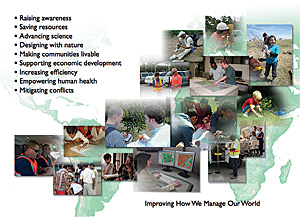
|